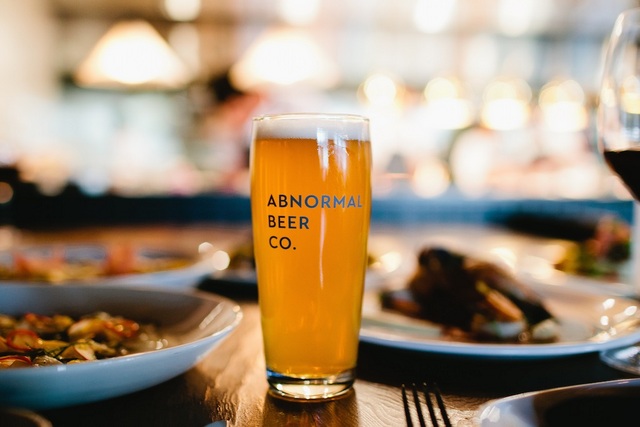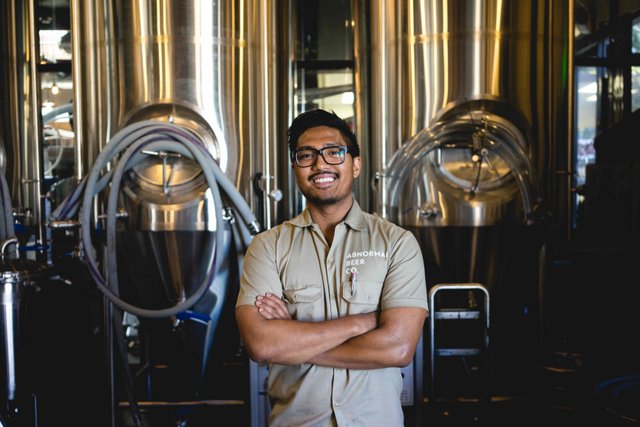
I quote a close friend: “Craft brewers must have a license to print money.” It was a statement uttered shortly after informing said friend about Cincinnati’s Fifty West Brewing’s $1.5 million expansion, which includes volleyball courts and a cycling business. It seems like every week we announce an exotic expansion or a how-is-that-even-possible success story — from the posh, new pub/restaurant/music venue/brewery that the folks at SLO Brew are building (replete with rentable lofts) to SweetWater Brewing’s announcement that it’s looking for not just one, but TWO new breweries to expand westward.
Sometimes, to the public, it must certainly appear that craft brewers are riding an unstoppable beer train of success (totally different from this snowpiercer), but is that perception a reality?
Just last week, San Diego-based Abnormal Beer Co., which has been brewing for only a whopping six months, announced a $1 million expansion investment to fulfill its growing demand, expanding its brewing facility and creating a private event space. In contrast to its nameplate, Abnormal Beer’s type of success doesn’t appear to be abnormal at all in the American brewing industry. Even historically, breweries have had an abnormal rate of success (perhaps a testament to our love of beer), according to what little info we could dig up on historical success and failure rates for breweries. We quote Bart Watson from the Brewers Association:
Here are the long term figures. Based on the 2013 data, 51.5 percent of the brewpubs and 76 percent of the microbreweries that have opened in the modern era (since 1980) are still open (so failure rates of 48.5 percent and 24 percent respectively). At first glance, this is a remarkable success story, far higher than rates for comparable industries/new businesses. One of the best studies I have seen on the restaurant industry found a 60 percent failure rate over a three-year period. These numbers also hint at the added complexity of running a brewpub, which essentially means running two businesses plus the synergies between them.
Let’s give that some perspective. According to the U.S. Bureau of Labor Statistics: About half of all new establishments (i.e. small businesses) survive five years or more and about one-third survive 10 years or more. After that, the probability of survival increases with a company’s age. So, that makes the numbers above exceedingly impressive — a little too impressive really.
“I might make the point that these historical rates are a guarantee of nothing, and that new entrants will have to work harder than ever to differentiate — particularly in places that already have a high density of breweries,” said Watson (when we asked for his latest insights). “I still agree with the statement that, for a while, openings actually created more opportunities — by introducing beer lovers to the concept of fully-flavored local beer and growing the market — but there are certainly some signs that era is ending in certain markets and that competition is increasing. I still think we have a lot of run room nationally. There are over 8,000 wineries in the United States, and Americans drink a lot more beer than wine.”
To give us perspective, Watson talks about “lagged rates” — comparing openings a few years back to closings a few years down the road. He gives us an example of a three-year lagged rate, and crunches all the numbers in this excellent chart, which takes total openings in 2010 compared with total closings in 2013:
Let’s start with the basics: Using this three-year lag period, the current lagged success rate of the brewpub category drops below 50%, to 43.9% … What about the micros? Interestingly, although the current three-year lagged success rate is still higher than brewpubs (57.5% versus 43.9%), the long-term average is virtually identical (53.5% vs 53.8%).
…
If we use the current success rate to think about future closures, the numbers are somewhat astounding. 836 breweries that we know of opened between 2010 and 2013. That means at a 57.5 percent three-year lagged success rate, you could use this to predict 356 micro closures by 2016.
Of course, that hasn’t happen yet, and growth continues while we wait (so grab a beer).
The new abnormal?
In September, the Brewers Association announced that the industry was now boasting 4,000 breweries in the United States. Those beautiful breweries are now located in more than 2,000 unique cities across all 50 states. That’s great, but how many have closed recently? Looking at info from the Craft Brewers Conference this year, there were 615 openings in 2014 vs. only 46 closings; 2013’s closings number was revised to 68. That’s crazy considering Watson’s insights above. Openings, in fact, are happening so quickly that we’re about to break the historical high of 4,131 breweries operating in the United States — a feat not broken since 1873 — a damn good year to drink beer. Is that sustainable? We point to a different CBB article:
There’s plenty of evidence that America can support a ton of new breweries. Germany has 1,300 breweries, with a heck of a lot less people. If the United States had the same number of breweries per capita (our population is over 3.8x bigger), that would mean 5,000 breweries.

Depending on your market competition, there actually may be still plenty of room to open up a craft brewery. If we broke down craft brewing into two segments for argument’s sake — 1) brewpubs (restaurants that produce and serve over 25 percent of their beer on-site over the counter) and 2) microbreweries (which by contrast sell over 75 percent of their production in bottles or kegs that are distributed to restaurants, bars and retail vendors) — we might find where some market potential lies. We quote this interesting article on Priceonomics
The success of brewpubs over the last few decades has made it harder to launch a new brewpub. The success of brewpubs and microbreweries, however, appears to have made it easier to open a microbrewery. Bart Watson explained to us, “In the nineties if you went to a major retailer, they’d probably laugh in your face if you told them you had a microbrew.” Today though, “people have paved the path.” The establishment of craft beer culture by its pioneers has created a market of restaurants and retailers looking to sell the wares of new microbreweries.
Without the distraction of running a restaurant, microbreweries can focus on their product. But as they sell at least 75% off-site, their success or failure revolves around distribution — their ability to get their beer to market in kegs for serving on draft in bars and restaurants, or sold in bottles or cans wholesale to retailers.
But economic trends (largely localized for new breweries) are tough to categorize. Take the case of aforementioned Abnormal Beer Co., which is not just a brewery, but also the Abnormal Wine Co. and The Cork & Craft Restaurant, based in Rancho Bernardo. Basically, it’s San Diego’s first craft brewery, urban winery and restaurant under one roof. We’re talking San Diego here — one of the most competitive beer/restaurant markets in the world. How are they succeeding?
“Our strategy and success stems from learning what makes the world’s craft beer market tick and applying that locally in San Diego,” said Elvin Lai, co-founder of Abnormal Beer. “We use that information to hone our skills to brew our own unique beers, engage the community we sell to and follow industry trends and large-scale investments. Essentially, we believe that if a company sets out to be the best and works to do so, that will be the outcome — and that’s what we’re in the process of doing. Playing to the advantage of being located in a business park, we have become the all-encompassing, one-stop shop that local beer enthusiasts, foodies, families, business professionals and locals alike are looking for.”
Success is certainly easier with a thorough plan, good product and untapped market. Speaking of which, let’s take a second to go over the numbers of this expansion. Abnormal Beer’s current fermentation capacity will grow from 80 barrels (bbls) to 440 bbls, increasing production by 550 percent. The expansion will add 2,000 square feet on to the existing 5,000-square-foot building, which also houses Abnormal Wine Co. and The Cork & Craft Restaurant. With the added space, Abnormal Beer Co. is enhancing its brewing facility with the following:
- A hot liquor tank and cold liquor tank to increase the rate of production;
- 11 additional 30- and 40-bbl fermenters to keep up with demand and expand their reach of customers; and
- A barrel-aging program for both sour and spirit barrel maturation.
It sounds like an awesome endeavor, and it’s already a successful one (for now). It’s just another example of how the dynamics behind the successes and failures of craft breweries in America have dramatically changed in the last 10 years. We hand the mic over to Watson in finale, who gives us two scenarios to think about for homework:
Scenario A. The new era of craft brewing is different and openings will no longer predict closings very well, this could be due to:
Increasing consumer demand
More friendly regulatory environments
Breweries leaning the lessons from the 1990s
All of the aboveScenario B. There is still a lagged relationship between openings and closings, but the timing has changed (i.e. breweries will close at similar rates but with a longer time period in between openings and closings).
Big ole thanks to Bart Watson for his help with this article. The guy’s clearly a rare beer brainiac, and we’re thankful he’s on our side.





Steve Body says
I wrote this back in February of 2016. At the end, I’ll update it to the current number of breweries:
“We now have a tad over 4,200 breweries in operation in the US, the largest number since the previous peak, 1873, just before the founding of Anheuser Busch, when American supported 4,044 brewers. The population of the entire country back then was about 38 million. That worked out to one brewery for every 9,500 citizens. Today, we are a nation of 320 million and there is a brewery for every 76,500 people. Simple arithmetic suggests that we can still support more breweries. And they’re coming, new ones every week, because an entire generation (a couple, actually) of beer fans have now found out that having Choices – instead of having ten or twenty beers that were all basically the same – is a Good Thing…and we are not EVER going back.”
That citizen to brewery ratio was predicated on a brewery population of just under 5,000. Today, craftbeer-dot-com puts the current number of craft breweries at 6,675. Let’s round that up to 7,000. The current US population is 325,700,000, rounded up at 327M At that number of breweries, the ratio becomes one brewery for every 46,714 people. And bear in mind that, in 1873, that was LONG before the advent of trucking for shipments of refrigerated rail cars and before the whole concept of wide-spread distribution. Breweries sold at least 95% of their beers LOCALLY, most right out of taps. Today’s breweries can bottle or can and fully trust that those beers will be perfectly viable, even after shipping coast to coast.
Breweries are failing at a rate FAR below most business categories. Breweries have an average three-year survival rate of 60%. Restaurants, by contrast, have a 60% FAILURE rate. MANY more breweries WILL fail but the overall health of brewing is a LOT more robust than most other businesses. The ONLY reason we hear all this alarm is because, for the first two full decades of the Craft Boom, craft brewers hardly failed AT ALL. Now, seeing a better-than-normal survival rate, people freak out. RELAX. Craft beer is performing better than all projections. Bad breweries will fail. Great breweries will survive.
Keith Gribbins says
Good stuff, Steve. Thanks!
Red Shed Brewery liked this on Facebook.
What are the historic success and failure rates of breweries? https://t.co/MEa92o3Nvv #CraftBeer #Brewery #BeerBiz https://t.co/Hoez27JOWE
What are the historic success and failure rates of breweries? https://t.co/IzR6LMSO8K
RT @FuuduCollective: What are the historic success and failure rates of breweries? https://t.co/LDUsdysRkC https://t.co/axWQMP2wXT
#craftbeer #beer #breweries #history #success … What are the historic success and failure rates of breweries? https://t.co/WnX5fYv70V
South Carolina Attorneys At Law liked this on Facebook.
RT @BrewStuds: Historic success and failure rates of breweries https://t.co/AsAmthofXF #beer #craftbeer #business https://t.co/QG57foXtjw
RT @BrewStuds: Historic success and failure rates of breweries https://t.co/AsAmthofXF #beer #craftbeer #business https://t.co/QG57foXtjw
What are the historic success and failure rates of breweries? https://t.co/lyfQxRfLww via craftbrewingbiz https://t.co/A2r1s6THEZ
RT @BrewStuds: Historic success and failure rates of breweries https://t.co/AsAmthofXF #beer #craftbeer #business https://t.co/QG57foXtjw
What are the historic success and failure rates of breweries? https://t.co/pvtJtQrIA1 via @craftbrewingbiz
RT @BrewStuds: Historic success and failure rates of breweries https://t.co/AsAmthofXF #beer #craftbeer #business https://t.co/QG57foXtjw
RT @BrewStuds: Historic success and failure rates of breweries https://t.co/AsAmthofXF #beer #craftbeer #business https://t.co/QG57foXtjw
RT @BrewStuds: Historic success and failure rates of breweries https://t.co/AsAmthofXF #beer #craftbeer #business https://t.co/QG57foXtjw
RT @BrewStuds: Historic success and failure rates of breweries https://t.co/AsAmthofXF #beer #craftbeer #business https://t.co/QG57foXtjw
RT @BrewStuds: Historic success and failure rates of breweries https://t.co/AsAmthofXF #beer #craftbeer #business https://t.co/QG57foXtjw
RT @BrewStuds: Historic success and failure rates of breweries https://t.co/AsAmthofXF #beer #craftbeer #business https://t.co/QG57foXtjw
Historic success and failure rates of breweries https://t.co/AsAmthofXF #beer #craftbeer #business https://t.co/QG57foXtjw
RT @AbnormalBeerCo: Got some National Press yesterday… https://t.co/a5SU2vO8o7 via @craftbrewingbiz
RT @FuuduCollective: What are the historic success and failure rates of breweries? https://t.co/LDUsdysRkC https://t.co/axWQMP2wXT
What are the historic success and failure rates of breweries? https://t.co/LDUsdysRkC https://t.co/axWQMP2wXT
Elvis Caudill liked this on Facebook.
Craft Beverage Expo liked this on Facebook.
Cynthia Chevarría Rodríguez liked this on Facebook.
Michael Nikkel liked this on Facebook.
Lee David liked this on Facebook.
U.S. Beverage Industry Expo liked this on Facebook.
Ryan Mader liked this on Facebook.
Eddy Fernández Solórzano liked this on Facebook.
Joshua Bennett liked this on Facebook.
RT @KCHopTalk: What are the historic success and failure rates of breweries? https://t.co/7WxFhQvsdI
Kimmy Flanigin liked this on Facebook.
Johnnie Brew liked this on Facebook.
Chris Davis liked this on Facebook.
Krones AG liked this on Facebook.
Kenneth Cannon liked this on Facebook.
Nikki Letendre Haase liked this on Facebook.
What are the historic success and failure rates of breweries? https://t.co/7WxFhQvsdI
RT @crsimp01: What are the historic success and failure rates of breweries? https://t.co/dtM5PzCKoO via @craftbrewingbiz
RT @crsimp01: What are the historic success and failure rates of breweries? https://t.co/dtM5PzCKoO via @craftbrewingbiz
RT @CraftBrewingBiz: What are the historic success and failure rates of breweries? https://t.co/G285vz02qG @AbnormalBeerCo gets us thinkin’
Serge Lubomudrov liked this on Facebook.
Scott Tucker liked this on Facebook.
Tomas Sluiter liked this on Facebook.
Larry Clouser liked this on Facebook.
Scott Bruman liked this on Facebook.
Josh Britton liked this on Facebook.
Brian Phipps liked this on Facebook.
What are the historic success and failure rates of breweries? https://t.co/3D9faERvCl
Tomas Sluiter
Lynne Hassin Britton liked this on Facebook.
Manuel G. Velilla liked this on Facebook.
#CraftBeer #CraftBrewing #Beer #BeerBiz What are the historic success and failure rates of breweries? https://t.co/3lXe0mwNaB
What are the historic success and failure rates of breweries? https://t.co/dtM5PzCKoO via @craftbrewingbiz
John Wanner liked this on Facebook.